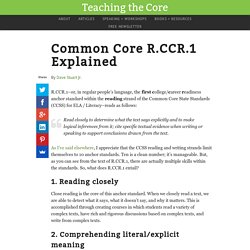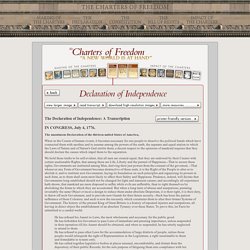

Rubric_Implicit/Explicit Language - Google Docs. Explicit Implicit Lang Solutions. Common Core R.CCR.1 Explained - Teaching the Core. R.CCR.1–or, in regular people’s language, the first college/career readiness anchor standard within the reading strand of the Common Core State Standards (CCSS) for ELA / Literacy–reads as follows: Read closely to determine what the text says explicitly and to make logical inferences from it; cite specific textual evidence when writing or speaking to support conclusions drawn from the text.

As I’ve said elsewhere, I appreciate that the CCSS reading and writing strands limit themselves to 10 anchor standards. Ten is a clean number; it’s manageable. But, as you can see from the text of R.CCR.1, there are actually multiple skills within the standards. So, what does R.CCR.1 entail? Explicit-Implicit Meaning LP. Tracy Kidder - An interview with author. An interview with Tracy Kidder Tracy Kidder discusses Strength in What Remains A Conversation with Tracy Kidder, author of Mountain Beyond Mountains How did you meet Paul Farmer, and what made you want to write about him?

I met him in Haiti in 1994. I was doing a story on American soldiers sent there to reinstate the country’s democratically elected government. And I was drawn to the man himself. My favorite teacher once used to talk about how writers often have their best stories bestowed upon them, seemingly by accident. What was Farmer’s initial response to your wanting to write a book about him and his work? What was involved in doing the research for this book? I also visited his mother and some of his siblings, and the places of his childhood.
What does the title, Mountains Beyond Mountains, mean? It was a childhood full of family adventures and misadventures and completely unconventional. There were other advantages, Farmer insisted. Farmer doesn’t work alone. Alice ExplicitLanguage. Declaration of Independence - Text Transcript. The Declaration of Independence: A Transcription IN CONGRESS, July 4, 1776.

The unanimous Declaration of the thirteen united States of America, When in the Course of human events, it becomes necessary for one people to dissolve the political bands which have connected them with another, and to assume among the powers of the earth, the separate and equal station to which the Laws of Nature and of Nature's God entitle them, a decent respect to the opinions of mankind requires that they should declare the causes which impel them to the separation. We hold these truths to be self-evident, that all men are created equal, that they are endowed by their Creator with certain unalienable Rights, that among these are Life, Liberty and the pursuit of Happiness.
He has refused his Assent to Laws, the most wholesome and necessary for the public good. Nor have We been wanting in attentions to our Brittish brethren. Transcript of the Constitution of the United States - Official Text. The Constitution of the United States: A Transcription Note: The following text is a transcription of the Constitution as it was inscribed by Jacob Shallus on parchment (the document on display in the Rotunda at the National Archives Museum.)

Items that are hyperlinked have since been amended or superseded. The authenticated text of the Constitution can be found on the website of the Government Printing Office. We the People of the United States, in Order to form a more perfect Union, establish Justice, insure domestic Tranquility, provide for the common defence, promote the general Welfare, and secure the Blessings of Liberty to ourselves and our Posterity, do ordain and establish this Constitution for the United States of America.
Article. Section. 1. All legislative Powers herein granted shall be vested in a Congress of the United States, which shall consist of a Senate and House of Representatives.